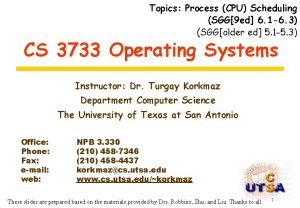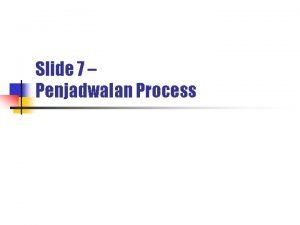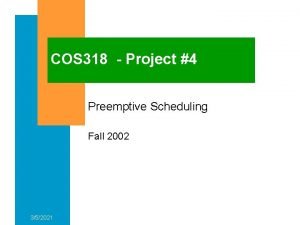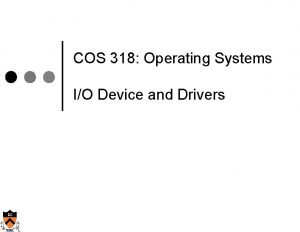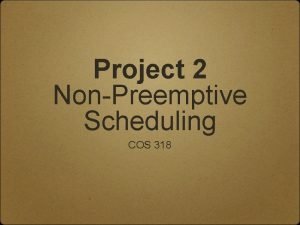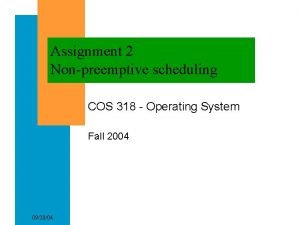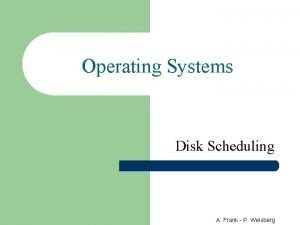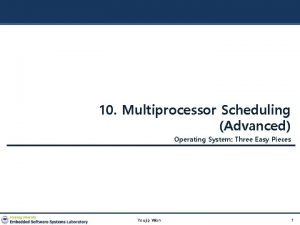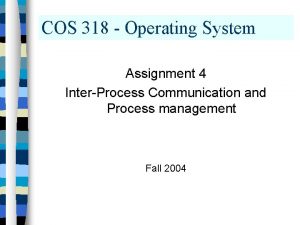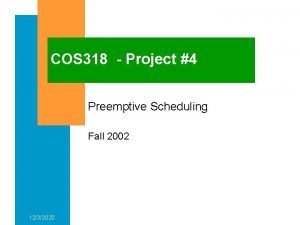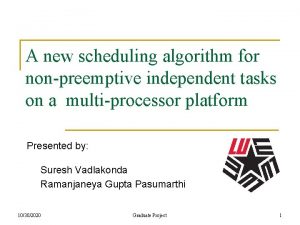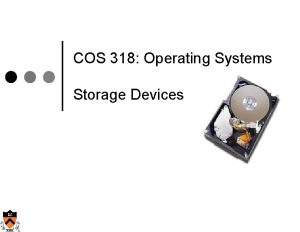Assignment 2 Nonpreemptive scheduling COS 318 Operating System














- Slides: 14

Assignment 2 Non-preemptive scheduling COS 318 - Operating System Fall 2004 09/30/04

Main things you need to deal with 09/30/04 Process Control Block (PCB) Context Switch procedure System Call mechanism Stacks Synchronization Inline assembly Design review requirements

Process Control Block (PCB) File: kernel. h What should be in the PCB? – pid, in_kernel, stack? – next, previous What else should goes in PCB? – Design review. 09/30/04

Context Switch Procedure How to switch between processes and threads? – They must call yield() explicitly. – Time slice expires. (Preemptive, next assignment) Where to save it? – Stack? – PCB. 09/30/04

System Call Mechanism How does a process get services from the kernel? – This assignment: special function call - a “jump table” – Real stuff: Interrupt/trap mechanism (later assignments) 09/30/04

System Call Mechanism (continued) At runtime, load the address of kernel_entry() into memory location 0 xf 00. How to do that? – Define this #define ENTRY_POINT (void(**)(int))0 xf 00 – Declare the following in syslib. c void (**entry_point)(int)=ENTRY_POINT – To load 09/30/04 *entry_point = kernel_entry

System Call Mechanism (continued) The following diagram shows the kernel_entry in the memory 0 xf 00 0 x 1000 kernel_entry() 09/30/04

Stacks How many stacks? – 2 per process, 1 pre thread. Why? Where to put them in memory? – Upper limit: 640 K (= 0 xa 0000) – Suggestion: between 0 x 10000 and 0 x 20000 – See memory layout on the next slide Size of each stack: – 4 KB should be fine. 09/30/04

Memory Layout BIOS 0 x 01000 0 x 07 C 00 Kernel and Processes Bootblock Stacks 0 x. A 0000 0 x. B 8000 09/30/04 Video RAM

Synchronization Locks are used by threads Many threads can try to acquire a lock – Need to maintain queue of threads waiting for a lock. (where? ) Lock_acquire() – 1. Check lock – 2. Get lock? Great! – 3. If not, block itself 09/30/04 Lock_init(), Lock_release()

Inline Assembly See guide on course page http: //linuxassembly. org/resources. html http: //linuxassembly. org/articles/rmiyagi-inline-asm. txt ask google. Ask us. To access a C variable in inline assembly – asm volatile(“statements”: output_regs: input_regs: used_regs); Examples – asm volatile(“movl %%esp, %0”: ”=q”(cur_running->stack)); – asm volatile(“movl %0, %%esp”: : ”q”(cur_running->stack)); 09/30/04

Design Review Process Control Block (PCB) – Whats in it ? Context Switch procedure System Call mechanism Stacks Synchronization – How are locks implemented ? 09/30/04 Will put up detailed grading scheme soon (tomorrow? )

Some more hints for this assignment 1. Flat Address Space 09/30/04 The bootblock code switches to protected mode. It also sets up the CS, DS, and other segment registers so that you can use the entire memory using just registers like eax. Do NOT modify the segment registers. You have access to the first 1 MB of memory which includes the video-memory area(0 x. B 8000). To be safe make sure your code, data, and stacks reside within the first 640 KB of memory.

Some more hints for this assignment 2. Synchronization 09/30/04 The synchronization primitives can only be used by threads within the kernel. You will notice that there are two functions block() and unblock() in the kernel that are to be used by the synchronization code. This has been done since blocking a process is not specific to locks, but is a general purpose service that the kernel should support.
 Difference between preemptive and nonpreemptive scheduling
Difference between preemptive and nonpreemptive scheduling Difference between preemptive and nonpreemptive scheduling
Difference between preemptive and nonpreemptive scheduling Contoh penjadwalan preemptive dan nonpreemptive
Contoh penjadwalan preemptive dan nonpreemptive Contoh penjadwalan preemptive dan nonpreemptive
Contoh penjadwalan preemptive dan nonpreemptive Task in process
Task in process Cos 318
Cos 318 Cos 318°
Cos 318° Cos
Cos Cos318
Cos318 Cos 318
Cos 318 Cos 318°=
Cos 318°= Cos 318
Cos 318 Cos318 fall 2021
Cos318 fall 2021 Disk scheduling policies
Disk scheduling policies Bf scheduler
Bf scheduler
